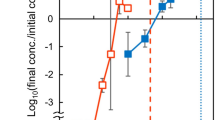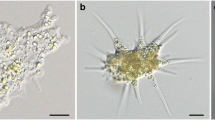Abstract
A long-living artificial tripartite symbiosis involving a green alga (Chlamydomonas), a bacterium (Azotobacter) and a fungus (Alternaria) was established on carbon- and nitrogen-free medium. The basis of the interdependence is the complementation of photosynthetic CO2 assimilation and atmospheric nitrogen fixation. Green color of the colonies indicated that the algal cells had enough nitrogen to synthesize chlorophylls. The chlorophyll content was nearly 40 % of the control cells. The relatively high rate of photosynthetic oxygen evolution proved that nitrogen was effectively used for building up a well functioning photosynthetic apparatus. This was supported by the analysis of photosystems and ultrastructural investigations. In comparison with degreened algae cultured on nitrogen-free medium, the chloroplasts in the symbiont algal cells contained a well-developed, stacked thylakoid membrane system without extreme starch or lipid accumulation. The occurrence of the fungus in the association greatly increased the chlorophyll content. Far fewer types of amino acids were excreted by the tripartite cultures than by pure cultures. Cystathionine, which is a common intermediate in the sulfur-containing amino acid metabolism, was produced in high quantities by the tripartite symbiosis. This can mostly be attributed to the activity of the fungus.
Similar content being viewed by others
References
Altschul S.F., Gish W., Miller W., Myers E.W., Lipman D.J.: Basic local alignment search tool. J.Mol.Biol.215, 403–410 (1990).
Frey-klett P., Garbaye J., Tarkka M.: The mycorrhiza helper bacteria revisited. New Phytol.176, 22–36 (2007).
Gyurján I., Nghia N.H., Tóth G., Turtóczky I., Stefanovits P.: Photosynthesis, nitrogen fixation and enzyme activities in Chlamydomonas — Azotobacter symbioses. Biochem.Physiol.Pflanzen181, 147–153 (1985).
Gyurján I., Korányi P., Paless G.Y.: Ultrastructural analysis of an artificial alga bacterium intracellular symbiosis after prolonged cultivation. Symbiosis14, 475–484 (1992).
Jakucs E., Kovács G.M., Szedlay Gy., Erős-Honti Zs.: Morphological and molecular diversity and abundance of tomentelloid ectomycorrhizae in broad-leaved forests of the Hungarian Plain. Mycorrhiza15, 459–470 (2005)
Joerger R.D., Jacobson M.R., Premakumar R., Wolfinger E.D., Bishop P.E.: Nucleotide sequence and mutational analysis of the structural genes (anfHDGK) for the second alternative nitrogenase form Azotobacter vinelandii. J.Bacteriol.171, 1075–1086 (1989).
Kathir P., Lavoie M., Brazelton W.J., Haas N.A., Lefebvre P.A., Silflow C.D.: Molecular map of the Chlamydomonas reinhardtii nuclear genome. Eukaryot.Cell2, 362–379 (2003).
Key B.J., White R.P.: Neuropharmacological comparison of cystathionine, cysteine, homoserine and α-ketobutyric acid in cats. Neuropharmacology9, 349–357 (1970).
Kneip C., Lockhart P., Voss C., Maier U.G.: Nitrogen fixation in eukaryotes — new models for symbiosis. BMC Evol.Biol.7, 55–66 (2007).
Kovács G.M., Vágvölgyi C., Oberwinkler F.: In vitro interaction of the truffle Terfezia terfezioides with Robinia pseudoacacia and Helianthemum ovatum. Folia Microbiol.48, 369–378 (2003).
Li C.Y., Hung L.L.: Nitrogen-fixing (acetylene-reducing) bacteria associated with ectomycorrhizae of Douglas-fir. Plant & Soil98, 425–428 (1987).
Lohret T.A., Zhao L., Quarmby L.M.: Cloning of Chlamydomonas p60 katanin and localization to the site of outer doublet severing during deflagellation. Cell Motil.Cytoskeleton43, 221–231 (1999).
Murakami A.: Quantitative analysis of 77 K fluorescence emission spectra in Synechocystis sp. PCC 6714 and Chlamydomonas reinhardtii with variable PSI/PSII stoichiometries. Photosynth.Res.53, 141–148 (1997).
Newton J.W., Wilson P.W., Burris R.H.: Direct demonstration of ammonia as an intermediate in nitrogen fixation by Azotobacter. J.Biol.Chem.204, 445–451 (1953).
Oldenhof H., Zachleder V., van Den Ende H.: The cell cycle of Chlamydomonas reinhardtii: the role of the commitment point. Folia Microbiol.52, 53–60 (2007).
Paracer S., Ahmadjian V.: Symbiosis. An Introduction to Biological Associations, 2nd. ed., pp. 65–77. Oxford University Press (USA) 2000.
Paul L.R., Chapman B.K., Chanway C.P.: Nitrogen fixation associated with Suillus tomentosus tuberculate ectomycorrhizae on Pinus contorta var. latifolia. Ann.Bot.99, 1001–1009 (2007).
Peltier G., Schmidt G.W.: Chlororespiration: an adaptation to nitrogen deficiency in Chlamydomonas reinhardtii. Proc.Nat.Acad.Sci. USA88, 4791–4795 (1991).
Plumley F.G., Schmidt G.: Nitrogen-dependent regulation of photosynthetic gene expression. Proc.Nat.Acad.Sci.USA86, 2678–2682 (1989).
Porra R.J., Thomson W.A., Kriedemann P.E.: Determination of accurate extinction coefficients and simultaneous equations for assaying chlorophyll a and b extracted with different solvents: verification of the concentration of chlorophyll standards by atomic absorption spectroscopy. Biochim.Biophys.Acta975, 384–394 (1989).
Preininger É., Pónyi T., Sarkadi L., Nyitrai P., Gyurján I.: Long-living Azotobacter-Chlamydomonas association as a model system for plant-microbe interactions. Symbiosis42, 45–50 (2006).
Sager R., Granick S.: Nutritional studies with Chlamydomonas reinhardtii. Ann.N.Y.Acad.Sci.56, 831–838 (1953).
Satoh A., Kurano N., Senger H., Miyachi S.: Regulation of energy balance in photosystems in responses to changes in CO2 concentrations and light intensities during growth in extremely-high-CO2-tolerant green microalgae. Plant Cell Physiol.43, 440–451 (2002).
Smith D.C.: Symbiosis: an overview, a definition and an examination of the aims of the Colloquium Endocytobiology IV. 4th Internat. Colloquium on Endocytobiology and Symbiosis, pp. 29–35. Villeurbanne (France) 1989.
Vogel S.L., Frisch H.L., Gotham I.J.: Qualitative assay of dissolved amino acids and sugars excreted by Chlamydomonas reinhardtii (Chlorophyceae) and Euglena gracilis (Euglenophyceae). J.Phycol.14, 403–406 (1978).
Wada K., Kamisaki Y., Kitano M., Nakamoto K., Itoh T.: Protective effect of cystathionine on acute gastric mucosal injury induced by ischemia-reperfusion in rats. Eur.J.Pharmacol.294, 377–382 (1995).
Watanabe K., Takihana N., Aoyagi H., Hanada S., Watanabe Y., Ohmura N., Saiki H., Tanaka H.: Symbiotic association in Chlorella culture. FEMS Microbiol.Ecol.51, 187–196 (2005).
White A.R., Huang X.D., Jobling M.F., Barrow C.J., Beyreuther K., Masters C.L., Bush A.I., Cappai R.: Homocysteine potentiates copper- and amyloid β peptide-mediated toxicity in primary neuronal cultures: possible risk factors in the Alzheimer’s-type neurodegenerative pathways. J.Neurochem.76, 1509–1520 (2001).
Author information
Authors and Affiliations
Corresponding author
Rights and permissions
About this article
Cite this article
Lőrincz, Z., Preininger, É., Kósa, A. et al. Artificial tripartite symbiosis involving a green alga (Chlamydomonas), a bacterium (Azotobacter) and a fungus (Alternaria): Morphological and physiological characterization. Folia Microbiol 55, 393–400 (2010). https://doi.org/10.1007/s12223-010-0067-9
Received:
Revised:
Published:
Issue Date:
DOI: https://doi.org/10.1007/s12223-010-0067-9




